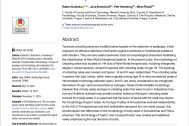Obsah
Tarantula urticating setae are modified setae located on the abdomen or pedipalps, which represent an effective defensive mechanism against vertebrate or invertebrate predators and intruders. They are also useful taxonomic tools as morphological characters facilitating the classification of New World theraphosid spiders. In the present study, the morphology of urticating setae was studied on 144 taxa of New World theraphosids, including ontogenetic stages in chosen species, except for species with urticating setae of type VII. The typology
of urticating setae was revised, and types I, III and IV were redescribed. The urticating setae in spiders with type I setae, which were originally among type III or were considered setae of intermediate morphology between types I and III, are newly considered to be ontogenetic derivatives of type I and are described as subtypes. Setae of intermediate morphology between that of body setae and type II urticating setae that were found in Iridopelma hirsutum and Antillena rickwesti may provide another evidence that type II urticating setae evolved from body setae. It is supposed that the fusion of barbs with the shaft may lead to the morphology of type II setae. As the type II setae of Aviculariinae evolved independently to the UrS of Theraphosinae and both subfamilies represent two non-sister groups, this should explain the differences in the morphology of body setae in Aviculariinae and Theraphosinae. The terminology of “barbs” and “reversed barbs” was revised and redefined, newly emphasizing the real direction of barbs.
of urticating setae was revised, and types I, III and IV were redescribed. The urticating setae in spiders with type I setae, which were originally among type III or were considered setae of intermediate morphology between types I and III, are newly considered to be ontogenetic derivatives of type I and are described as subtypes. Setae of intermediate morphology between that of body setae and type II urticating setae that were found in Iridopelma hirsutum and Antillena rickwesti may provide another evidence that type II urticating setae evolved from body setae. It is supposed that the fusion of barbs with the shaft may lead to the morphology of type II setae. As the type II setae of Aviculariinae evolved independently to the UrS of Theraphosinae and both subfamilies represent two non-sister groups, this should explain the differences in the morphology of body setae in Aviculariinae and Theraphosinae. The terminology of “barbs” and “reversed barbs” was revised and redefined, newly emphasizing the real direction of barbs.



